Problem: Determine whether the following function is
![]()
Solution: First note that the domain of f is all real numbers
apart from
To determine injectivity we use the standard approach. We take x1, x2 from the domain, assume that they give the same value when substituted into f and we check whether there is some other solution besides the trivial one.
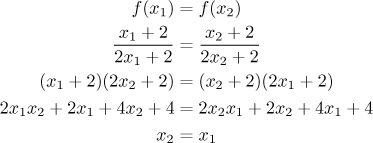
We see that the only way to get the same value is to start from the same
place, which shows that the function is
Now we find the inverse function by solving the equation

Now we need to investigate monotonicity. So far we know only the
definition, so we will try to establish one of the two necessary
implications. We take arbitrary two numbers
How do we establish those implications? We start with the inequality
Fortunately, the given function is a ratio of linear functions, for which we have a very handy favourite trick: We divide with remainder. In fact, for this particular case there isan alternative for the usual algorithm for long division. Namely, we create the expression in the denominator also on the top, first we create the appropriate number of x on the top by multiplying/dividing, then we use addition/substraction to also fix the absolute term. We will write all details, with a bit of experience this can be done very quickly.

This kind of expression we may try to create, we always start from x in this expression and keep going out in the order of evaluation. First we multiply both sides by 2, then add 2.
![]()
The next step is to move the linear terms into denominators on the opposite
sides of the inequality. This is done by dividing the whole inequality by the
appropriate term, but here we have a big problem. When dividing an
inequality, the sign of the number that we divide with determines whether we
should switch the direction of inequality or not. Here we do not know, so as
usual we will look at all possibilities. We start by assuming that
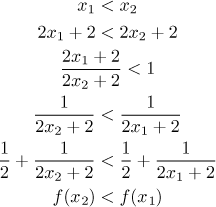
We divided first by
Now we have to look at the other alternative, when

In the next step we would like to divide by
The "good" case is when also
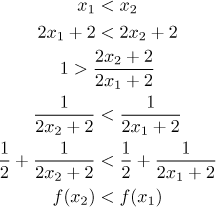
Just as before, the direction in comparison was reversed and the condition
Right now we can conclude that
f is decreasing on
But we were asked to investigate, so perhaps more is expected. Can we put the two sets together into one set (not an interval) and say that the function is decreasing or perhaps non-increasing on its domain? (Given monotonicity on the two subintervals, no other monotonicity is possible now.) Right now we do not know, so we need to do more work.
Which brings us to the last case for variables, when
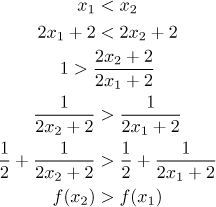
This time we obtained an implication that suggests increase, which does not
sound good. We claim that our function is not monotone on its domain. It
cannot be increasing or non-decreasing because of it behaviour on the two
intervals. Possibility of being decteasing or non-increasing is ruled
out by the latest calculation. Indeed, we can choose, say,
Note that strict monotonicity implies injectivity, from the decreasing
parts we therefore know that f is
Note also that the "divided" form of the ratio of linear functions
makes also other calculatios easier. We briefly return to the first two
topics. First we check that this function is
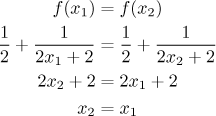
Now we find the inverse function.

It is easy to check that we got the same answer.